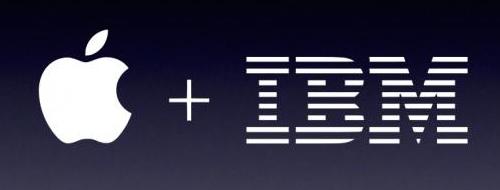- July 21, 2014
- Joe
- knowledge
- No Comments
Last week Apple-IBM break ended in a new reunion, promising to renew their vows on this new stage of their relationship. Yes, this relationship is not new, is an old love-hate adventure the two of them need in order to keep them in business they neither attack correctly. Apple on the corporate side, IBM on the consumer side.
Corporate
Today, specially on established (i.e. More than 10 years in operation, medium to big) companies, is rare that it has an IT department. The way it goes on the IT side, is by outsourcing this task to other companies like IBM, HP, CSC, etc. These outsourcing companies do most of the IT chores going from buying the laptop/PC of the employees, to handling support tickets and everything in between. This is specially true with companies that have thousands of employees located worldwide. The IT task under these circumstances is a company in itself, and since IT is not the chore business of many of these companies, outsourcing is the logical path of operation.
Apple
Steve Jobs admitted that he didn’t like the corporate world as a customer because he didn’t understood it. As such, during the time he was at the company (before & after his comeback), Apple shun away from the corporate world.
While Jobs was not at Apple, indeed the company made efforts to gain corporate acceptance, and it did manage to obtain some. The OS for the Mac got some really interesting functionality geared to the corporate world. AppleTalk (the network protocol from Apple), was a very good and advanced one, being able to handle small to big networks easily. Easily, meaning easy to deploy. However, it was also true that part of Apple’s decadence in the 90’s was due to the low acceptance rate on the corporate side, on which the Wintel duopoloy was king.
IBM
It was also no secret that IBM made machines for the corporate world with no interest on the consumer world.
Until last week, Apple still didn’t attend directly the corporate customer and IBM doesn’t know what the word consumer means. As such, this new agreement brings the best of both worlds together. IBM will distribute Apple gear to their corporate customers, and Apple can gain formal track record on the corporate side without the need to specifically address or design for that market. IBM will take care of those details for their customers. Also, if any company wants proper or formal support of their or future Apple gear, then one way or another, they’ll need to deal with IBM. I’m not so sure of how many IT managers are happy with that, but that’s the way life goes.
This relationship goes way back
However what’s surprising is that many people is taking this agreement as something new, when in fact, there’s a history. It’s called AIM alliance, let’s start.
In the beginning there was the original Macintosh, which incorporated this new CPU from Motorola, baptized 68000. From there on, Macs will only use this CPU, different to the DOS/Windows side, which used the x86 architecture. The Motorola CPU was more advanced than the x86, however we all know that technical advances matter little on the whole picture. Both 68xxx and x86 architectures were CISC (Complex Instruction Set Computer). When the Mac was launched IBM was the “enemy”, but then the real enemy turned out to be the Wintel doupoly. During the early 90’s it was clear that Macs were not going to overtake the PCs, so in order to overtake them, a new radical approach must be taken.
Give them POWER!
Thanks to the Wintel duopoly, IBM was also left out of that money party. However, IBM has had always great research, coming out of it was another product which were based on another type of CPU, this time those CPUs were the RISC (Reduced Instruction set Computer) type. RISC CPUs software was bigger in storage and memory requirement size, but it performed way faster than an equivalent software executed on CISC CPUs. IBM baptized this CPU architecture: POWER (Power Optimized with enhanced RISC).
So, Motorola and Apple were married, however that marriage had economic problems, so if they wanted to continue being economically healthy, something must be done. So they decided to invite IBM to form Ménage à trois and create the AIM (Apple, IBM, Motorola) alliance. IBM designed the CPU, Motorola manufactured it (yes, Motorola used to be a big company too) and Apple sold the computers with the new and flashy PowerPC CPU.
Of course, this was done during the time Jobs was not around Apple. The new PowerPC architecture was going to also allow Mac clones, heresy to some of us!
As a fruit of this orgy, Apple released the PowerPC (6100,7100 and 8100 models), the first RISC based desktop. They were indeed really fast computers … when there was software for it. As I mentioned earlier, RISC required software to be geared for it, and until that moment, previous Mac software was written for the ancient 68xxx. Thus all Mac developers needed to re-write their software to be compatible with the new PowerPC, however, while the initial sales were impressive, as time passed sales declined, leaving developers with little incentive to rewrite their application to take full advantage of the new CPU. To complicate matters even more, the first guilty of charge on all this was Apple. The OS was not updated to take full advantage of it, so it ran slower on newer Macs than the older ones. Why was it not updated? Well because it was also obsolete. So Apple embarked in -also- this new endeavour of building a new modern OS to take advantage of this new modern CPU. It was going to be Mac OS 8 and support many of the things Windows 95 was already doing: Multitasking and Multithreading.
Apple failed miserably to bring Mac OS 8 to end. What could have been one of the greatest product in computer history (PowerPC), turned out to be on of the greatest mismanage projects in computer history. Mac OS 8 never came to be what was planned to. There was multitasking (sort of), but not multithreading, putting Mac OS on serious disadvantage against Win 95. On top of that, still it wasn’t 100% PowerPC native, yes, it was faster, but not all it could be. Remember they were *not* selling for the corporate world as they would have like to? Put that, half baked product, Win 95 going to the roof, and there was little consumer interest on Mac as a general, which in turn sent the whole company in a down spiral.
This time, something more radical than the previous was needed to be made. So Apple went to look for shopping a new OS. There were two candidates: BeOS and NeXT. Both were multithreading and multitasking (i.e. modern), both could be rewritten with little effort to the PowerPC (BeOS was already native for PowerPC), and both came from former Apple people. BeOS was the child of Jean-Louis Gassée while NeXT was the offspring of Steve Jobs. All in all, BeOS was a better fit for the Mac, Gassée knew this and lost. Legends says BeOS requested too much for it to Apple. On the other side, NeXT didn’t asked too much (relatively speaking, of course).
And so, Apple bought NeXT and the rest is history, right?
Well, no. Once Jobs was in command, he immediately cancelled the clone program, but the AIM trio was kept alive, in reality there was no other option. NeXT OS became OS X, this time, instead of a little rewriting to be compatible, an application for the OS X required a complete rewrite, in order to be fully compatible with OS X. But hey, it was at least fully PowerPC optimized! At that time Mac marketshare was so little, that it didn’t matter the cost of rewriting the software, either the publisher supported the Mac or not. Most of them, decided not to. Nevertheless, it took OS X three iterations (about three years) to become fairly usable, it wasn’t ready just like that.
In any case Apple managed to survive, the PowerPC was still a more advanced CPU than the x86, however by way of raw power (Megahertz race), x86 was closing the gap in performance that the PowerPC offered.
The devil is in the details
Mac sales while healthy, were not enough neither for Motorola nor for IBM. Jobs being Jobs, demanded specs that didn’t justify the R&D cost for both (Moto & IBM), so they dragged their feet. To put it in another context, today Apple can afford to have their own CPU for the iOS platform, simply because of the sheer volumen of devices sold, even if Apple didn’t built one, they would have easily manufacturers knocking to theirs doors just to adapt to their needs. Well, that was not the case in early 2000s with the Macs.
During this time, one of Apple engineers managed to run OS X on a x86 machine. At that time, putting the PowerPC on a laptop was costly and not that efficient, IBM promised a new version to Apple, which never came because the sales number never motivated them. Again, a radical move was needed.
So, Apple decided to move completely the Mac architecture to the x86. Arguing that IBM did’t deliver. IBM didn’t even bothered to counter Apple’s argument, they simply walked away from the trio, at that time was simply too little to bother. But lets not forget that those POWER CPUs were in many servers IBM sold and were the base for this new futuristic game console called: Play Station 3. The POWER architecture did bring great benefits, for IBM that is. Motorola CPU business began to diminish, not because of Apple, but certainly Apple stopping being their customer helped.
Again, on Macs it was needed to rewrite the software to be compatible with x86, only this time OS X was finished and completely native (x86) by the time Apple announced and published, this time the rest is history!

